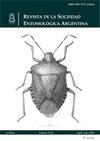哥伦比亚沃州米图市Santa María de Itapiima和Piracemo土著社区对可食用昆虫的感知和使用
IF 0.5
4区 农林科学
Q4 ENTOMOLOGY
引用次数: 0
摘要
哥伦比亚亚马逊东部的土著社区保留了他们利用资源的传统知识。昆虫已被用作替代食物,已被列入他们的日常饮食的一部分。在位于vaupsamas省Cuduyarí河流域的Santa María de Itapinima和Piracemo群落中记录了14种可食用昆虫,隶属于5目15科。根据其使用价值,mojojoy Rhynchophorus palmarum (L.)(鞘翅目:Curculionidae), manvara Syntermes spinosus (Latreille) (bltodea: Termitidae),切叶蚁Atta laevigata (F. Smith)(膜翅目:Formicidae)和几种俗称tapurú的蛾毛虫(鳞翅目)是最重要的食用昆虫。对每个物种建立了生态日历,记录了其采集技术和方法,以及传统的制备和消费方式。通过社区教学讲习班,提出了保护和可持续利用食用昆虫的战略,确定了研究重点,以改善社区的粮食安全。本文章由计算机程序翻译,如有差异,请以英文原文为准。
Perception and use of edible insects in Santa María de Itapinima and Piracemo indigenous communities, Mitú, Vaupés, Colombia
The indigenous communities of the Colombian Amazon East maintain their traditional knowledge for the use of their resources. Insects have been used as an alternative food that has been included as part of their daily diet. Fourteen species of edible insects belonging to 15 families of five orders were recorded in the communities of Santa María de Itapinima and Piracemo, located on the he Cuduyarí River in the department of Vaupés. According to its use value, mojojoy Rhynchophorus palmarum (L.) (Coleoptera: Curculionidae), manivara Syntermes spinosus (Latreille) (Blattodea: Termitidae), leaf-cutting ant Atta laevigata (F. Smith) (Hymanoptera: Formicidae) and several species of moth caterpillars (Lepidoptera) commonly called as tapurú, are the most important species of edible insects. For each species, its ecological calendar was established, and its collecting techniques and methods, and traditional forms of preparation and consumption were documented. Through community pedagogical workshops, strategies for the conservation and sustainable use of edible insects were proposed, identifying research priorities in order to improve the food security of communities.
求助全文
通过发布文献求助,成功后即可免费获取论文全文。
去求助
来源期刊

Revista De La Sociedad Entomologica Argentina
Agricultural and Biological Sciences-Insect Science
CiteScore
0.80
自引率
20.00%
发文量
31
审稿时长
20 weeks
 求助内容:
求助内容: 应助结果提醒方式:
应助结果提醒方式:


